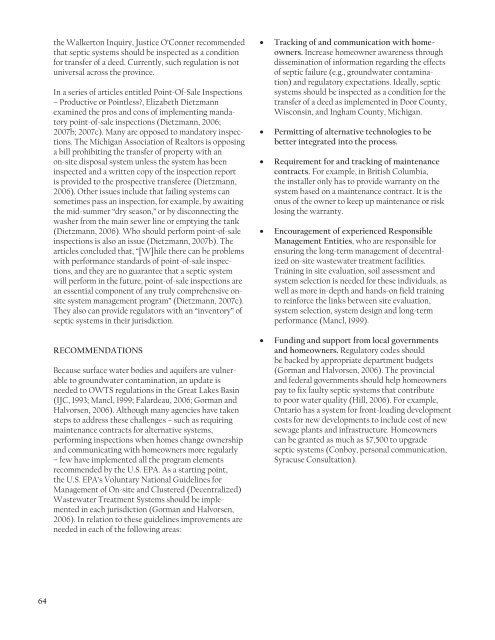Groundwater in the Great Lakes Basin
Groundwater in the Great Lakes Basin
Groundwater in the Great Lakes Basin
You also want an ePaper? Increase the reach of your titles
YUMPU automatically turns print PDFs into web optimized ePapers that Google loves.
<strong>the</strong> Walkerton Inquiry, Justice O’Conner recommended<br />
that septic systems should be <strong>in</strong>spected as a condition<br />
for transfer of a deed. Currently, such regulation is not<br />
universal across <strong>the</strong> prov<strong>in</strong>ce.<br />
In a series of articles entitled Po<strong>in</strong>t-Of-Sale Inspections<br />
– Productive or Po<strong>in</strong>tless?, Elizabeth Dietzmann<br />
exam<strong>in</strong>ed <strong>the</strong> pros and cons of implement<strong>in</strong>g mandatory<br />
po<strong>in</strong>t-of-sale <strong>in</strong>spections (Dietzmann, 2006;<br />
2007b; 2007c). Many are opposed to mandatory <strong>in</strong>spections.<br />
The Michigan Association of Realtors is oppos<strong>in</strong>g<br />
a bill prohibit<strong>in</strong>g <strong>the</strong> transfer of property with an<br />
on-site disposal system unless <strong>the</strong> system has been<br />
<strong>in</strong>spected and a written copy of <strong>the</strong> <strong>in</strong>spection report<br />
is provided to <strong>the</strong> prospective transferee (Dietzmann,<br />
2006). O<strong>the</strong>r issues <strong>in</strong>clude that fail<strong>in</strong>g systems can<br />
sometimes pass an <strong>in</strong>spection, for example, by await<strong>in</strong>g<br />
<strong>the</strong> mid-summer “dry season,” or by disconnect<strong>in</strong>g <strong>the</strong><br />
washer from <strong>the</strong> ma<strong>in</strong> sewer l<strong>in</strong>e or empty<strong>in</strong>g <strong>the</strong> tank<br />
(Dietzmann, 2006). Who should perform po<strong>in</strong>t-of-sale<br />
<strong>in</strong>spections is also an issue (Dietzmann, 2007b). The<br />
articles concluded that, “[W]hile <strong>the</strong>re can be problems<br />
with performance standards of po<strong>in</strong>t-of-sale <strong>in</strong>spections,<br />
and <strong>the</strong>y are no guarantee that a septic system<br />
will perform <strong>in</strong> <strong>the</strong> future, po<strong>in</strong>t-of-sale <strong>in</strong>spections are<br />
an essential component of any truly comprehensive onsite<br />
system management program” (Dietzmann, 2007c).<br />
They also can provide regulators with an “<strong>in</strong>ventory” of<br />
septic systems <strong>in</strong> <strong>the</strong>ir jurisdiction.<br />
RECOMMENDATIONS<br />
Because surface water bodies and aquifers are vulnerable<br />
to groundwater contam<strong>in</strong>ation, an update is<br />
needed to OWTS regulations <strong>in</strong> <strong>the</strong> <strong>Great</strong> <strong>Lakes</strong> Bas<strong>in</strong><br />
(IJC, 1993; Mancl, 1999; Falardeau, 2006; Gorman and<br />
Halvorsen, 2006). Although many agencies have taken<br />
steps to address <strong>the</strong>se challenges – such as requir<strong>in</strong>g<br />
ma<strong>in</strong>tenance contracts for alternative systems,<br />
perform<strong>in</strong>g <strong>in</strong>spections when homes change ownership<br />
and communicat<strong>in</strong>g with homeowners more regularly<br />
– few have implemented all <strong>the</strong> program elements<br />
recommended by <strong>the</strong> U.S. EPA. As a start<strong>in</strong>g po<strong>in</strong>t,<br />
<strong>the</strong> U.S. EPA’s Voluntary National Guidel<strong>in</strong>es for<br />
Management of On-site and Clustered (Decentralized)<br />
Wastewater Treatment Systems should be implemented<br />
<strong>in</strong> each jurisdiction (Gorman and Halvorsen,<br />
2006). In relation to <strong>the</strong>se guidel<strong>in</strong>es improvements are<br />
needed <strong>in</strong> each of <strong>the</strong> follow<strong>in</strong>g areas:<br />
• Track<strong>in</strong>g of and communication with homeowners.<br />
Increase homeowner awareness through<br />
dissem<strong>in</strong>ation of <strong>in</strong>formation regard<strong>in</strong>g <strong>the</strong> effects<br />
of septic failure (e.g., groundwater contam<strong>in</strong>ation)<br />
and regulatory expectations. Ideally, septic<br />
systems should be <strong>in</strong>spected as a condition for <strong>the</strong><br />
transfer of a deed as implemented <strong>in</strong> Door County,<br />
Wiscons<strong>in</strong>, and Ingham County, Michigan.<br />
• Permitt<strong>in</strong>g of alternative technologies to be<br />
better <strong>in</strong>tegrated <strong>in</strong>to <strong>the</strong> process.<br />
• Requirement for and track<strong>in</strong>g of ma<strong>in</strong>tenance<br />
contracts. For example, <strong>in</strong> British Columbia,<br />
<strong>the</strong> <strong>in</strong>staller only has to provide warranty on <strong>the</strong><br />
system based on a ma<strong>in</strong>tenance contract. It is <strong>the</strong><br />
onus of <strong>the</strong> owner to keep up ma<strong>in</strong>tenance or risk<br />
los<strong>in</strong>g <strong>the</strong> warranty.<br />
• Encouragement of experienced Responsible<br />
Management Entities, who are responsible for<br />
ensur<strong>in</strong>g <strong>the</strong> long-term management of decentralized<br />
on-site wastewater treatment facilities.<br />
Tra<strong>in</strong><strong>in</strong>g <strong>in</strong> site evaluation, soil assessment and<br />
system selection is needed for <strong>the</strong>se <strong>in</strong>dividuals, as<br />
well as more <strong>in</strong>-depth and hands-on field tra<strong>in</strong><strong>in</strong>g<br />
to re<strong>in</strong>force <strong>the</strong> l<strong>in</strong>ks between site evaluation,<br />
system selection, system design and long-term<br />
performance (Mancl, 1999).<br />
• Fund<strong>in</strong>g and support from local governments<br />
and homeowners. Regulatory codes should<br />
be backed by appropriate department budgets<br />
(Gorman and Halvorsen, 2006). The prov<strong>in</strong>cial<br />
and federal governments should help homeowners<br />
pay to fix faulty septic systems that contribute<br />
to poor water quality (Hill, 2006). For example,<br />
Ontario has a system for front-load<strong>in</strong>g development<br />
costs for new developments to <strong>in</strong>clude cost of new<br />
sewage plants and <strong>in</strong>frastructure. Homeowners<br />
can be granted as much as $7,500 to upgrade<br />
septic systems (Conboy, personal communication,<br />
Syracuse Consultation).<br />
64

















